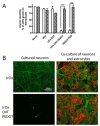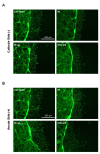Nanocarbon-Iridium Oxide Nanostructured Hybrids as Large Charge Capacity Electrostimulation Electrodes for Neural Repair
- PMID: 34299511
- PMCID: PMC8303498
- DOI: 10.3390/molecules26144236
Nanocarbon-Iridium Oxide Nanostructured Hybrids as Large Charge Capacity Electrostimulation Electrodes for Neural Repair
Abstract
Nanostructuring nanocarbons with IrOx yields to material coatings with large charge capacities for neural electrostimulation, and large reproducibility in time, that carbons do not exhibit. This work shows the contributions of carbon and the different nanostructures present, as well as the impact of functionalizing graphene with oxygen and nitrogen, and the effects of including conducting polymers within the hybrid materials. Different mammalian neural growth models differentiate the roles of the substrate material in absence and in presence of applied electric fields and address optimal electrodes for the future clinical applications.
Keywords: charge capacity; electrostimulation; iridium oxide; nanocarbons; repair.
Conflict of interest statement
The authors declare there is no conflict of interests.
Figures















References
-
- Frackowiak E., Beguin F. Carbon materials for the electrochemical storage of energy in capacitors. Carbon. 2001;39:937–950. doi: 10.1016/S0008-6223(00)00183-4. - DOI
-
- Deng X., Li J., Ma L., Sha J., Zhao N. Three-dimensional porous carbon materials and their composites as electrodes for electrochemical energy storage systems. Mater. Chem. Front. 2019;3:2221–2245. doi: 10.1039/C9QM00425D. - DOI
-
- Lyu L., Seong K.D., Ko D., Choi J., Lee C., Hwang T., Cho Y., Jin X., Zhang W., Pang H., et al. Recent developent of biomass-derived carbons and composites as electrode materials for supercapacitors. Mater. Chem. Front. 2019;3:2543–2570. doi: 10.1039/C9QM00348G. - DOI
-
- Zhang G., Han Y., Shao C., Chen N., Sun G., Jin X., Gao J., Ji B., Yang H., Qu L. Processing and manufacturing of graphene-based microsupercapacitors. Mater. Chem. Front. 2018;2:1750–1764. doi: 10.1039/C8QM00270C. - DOI
Publication types
MeSH terms
Substances
Grants and funding
LinkOut - more resources
Full Text Sources

